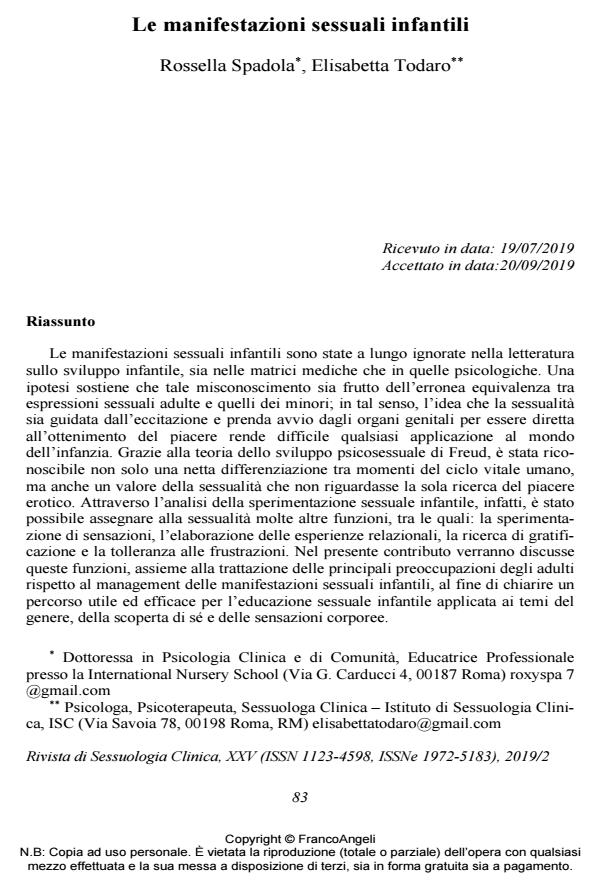Sexual expressions in children
Journal title RIVISTA DI SESSUOLOGIA CLINICA
Author/s Rossella Spadola, Elisabetta Todaro
Publishing Year 2019 Issue 2019/2 Language Italian
Pages 23 P. 83-105 File size 260 KB
DOI 10.3280/RSC2019-002005
DOI is like a bar code for intellectual property: to have more infomation
click here
Below, you can see the article first page
If you want to buy this article in PDF format, you can do it, following the instructions to buy download credits

FrancoAngeli is member of Publishers International Linking Association, Inc (PILA), a not-for-profit association which run the CrossRef service enabling links to and from online scholarly content.
Sexual expression in children has been ignored for a long time within the literature, both in medical and psychological fields. A hypothesis suggests a wrong equivalence between adult and infant sexual expressions; in this sense, the idea that sexuality is guided by excitement and starts from the genital area to achieve pleasure make difficult any application to childhood. Referring to infantile sexuality, it is important to understand that we are not talking about a genital sexuality, but a pregenital once, which is completely dif-ferent from the first. The pregenital sexuality manifestations are connected to specific areas and functions of the body, or relational functions too. The child ex-periences the pleasure (or displeasure), coming from the contact of the body, in his significant relationships with the adult, as a result of being nourished, cleaned, washed, carried, kissed, caressed, swayed, cuddled, admired and involved. Thanks to all these experiences, the child learns that through the body it is possible to "manage" or "store" some experiences. Therefore, through the body, the child will look for a strategy to overcome or make his own emotions, such as boredom, eu-phoria, anger and sadness. Thanks to Freud’s psychosexual development theory, it was recognized a clear differentiation between childhood and adulthood. Moreover, sexuality that does not concern only the search for erotic pleasure. In fact, through the analysis of infantile sexual experience, it was possible to assign many other functions to sexuali-ty, including feeling sensations, the elaboration of relational experiences, the search for gratification and the tolerance to frustration. In continuity with the European Standards for Sexual Education, it is presented an approach in which sex education begins at birth. Children begin the process of learning their sexuality as soon as they are born. Master and Johnson have shown, like many other scholars, that it is possible to detect a genital response already dur-ing fetal life through ultrasound. At the birth, parents begin, implicitly and explicitly, to transmit to the children messages concerning the body, the intimacy, the relationship and the integration between experiences and perception. While, on the one hand, children need love and support to form their own sexual identity, on the other they need to acquire knowledge and skills, for which formal education programs play an important role. Sex education supports the child’s sensory development, the perception of his own body and a positive body image; at the same time, it strengthens self-confidence and contributes to developing the capacity for self-determination. The child acquires the ability to behave responsibly towards him-self and others; learns that there are social norms to be respected and to recognize. In this way, therefore, sex education is also education in social and relational life. The present work discuss all these functions, together with the possible management of infantile sexual manifestations, in order to clarify a useful and effec-tive path for infantile sex education applied to gender issues, self-discovery and body sensations. It is clear that it can be very difficult for parents to manage some particular behaviors observed in their children regarding sexual stimulations, because of dif-ferent emotional and cultural aspects. At the same time, teachers can often ob-serve these behaviors without having a clear idea of what and how to do. This lack of definition can be linked and explained to many reasons, discussed in the present work. In general, in these cases it is important to assume an holistic vision for sex education, which provides impartial information on all aspects (physical, af-fective, social, cultural). The central prerequisite for sex education is that it has its space at school and is included in the curriculum programs; moreover, it should be implemented in an interactive way, taking into account the experiences and needs of the children and adolescents included.
Keywords: Sexual development, sexual education, body, gender identity, promotion, sexual health.
Rossella Spadola, Elisabetta Todaro, Le manifestazioni sessuali infantili in "RIVISTA DI SESSUOLOGIA CLINICA" 2/2019, pp 83-105, DOI: 10.3280/RSC2019-002005